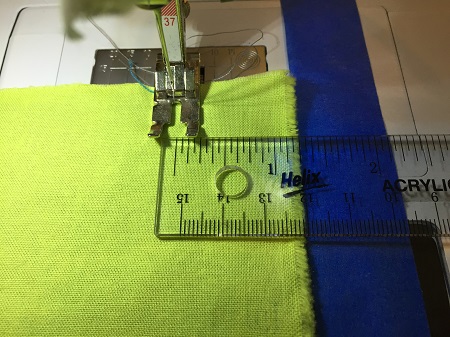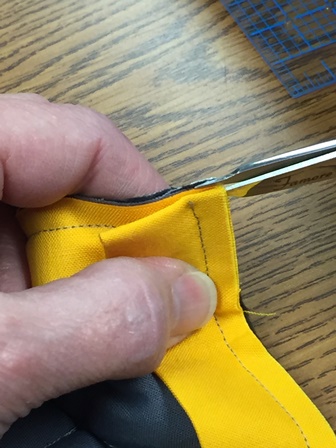How to piece quilt backs
We quilters spend hours and hours choosing fabric for our quilt tops trying to find just the perfect pattern or shade, and even longer cutting out the fabric and piecing it together. We do our best to have straight seam lines, accurate piecing, and smooth pressing. It’s easy to get complacent when it comes to preparing the backing fabric because once the top is done we are super anxious to get the project finished. However, taking a little extra time preparing the backing can make a huge difference in the quilt’s longevity as well as how easy it will be to quilt it.
Grain line and seam direction are two considerations when calculating backing yardage. If your quilt will hang on a wall or in a quilt show, plan to have the lengthwise fabric grain run from top to bottom. This will help stabilize the quilt and prevent sagging over time. Lengthwise grain runs parallel to the fabric selvages as shown in the photo below:

If you are using wide quilt backing then purchase enough so that you can orient the backing correctly for this scenario. However, if you must piece 44-inch wide lengths of fabric together to make your backing large enough, use the hints below to reduce stress on the quilt (and if you’re using a longarm machine for the project, to reduce stress on the quilter!)
Join backing fabric sections with a ½-inch seam allowance instead of a traditional ¼-inch allowance on the backing. This helps reduce bulk at each seam and makes it flatter.
Use a shorter stitch length of 10 – 12 stitches per inch for a sturdy seam.
If your machine does not have a built-in walking foot you may want to use one on long seams to keep the pieces from shifting as you sew.
Remove the selvage edges before sewing the pieces together, or try this shortcut:
- Measure the width of your selvage and add ½-inch to that measurement. Place a piece of painter’s tape on your sewing machine to the right of the needle at that distance. (In the photo below, my selvage is ¾-inch wide so I have placed a piece of painter’s tape 1-1/4 inches away from my needle on the right side.)

- Align the edges of your fabric (RST) with the edge of the painter’s tape and sew the seam.
- Now trim the selvedge off using a scissors or rotary cutter leaving a ½-in seam allowance.

Press seams open to reduce bulk.

This is really helpful for longarm quilters since seams that wrap around the table rollers can cause distortion and increase the chance for pleats and puckers in the back. Take a look at the two photos below—notice how the seam in the first photo bulges around the roller since the seam is pressed to one side? The second photo shows how much better the fabric wraps around the roller with the seam pressed open.


Avoid placing the backing seam in the center. Since quilts are typically folded vertically and horizontally in the center, the excess fabric in the seam allowance increases wear as well as increases the chance of permanent creases. Off-set the seam to the left or right of center.
Alternatively, center one main fabric panel on the back and add two smaller panels on the left and right sides to create two seams.

If your quilt will not hang, then consider putting the backing seam horizontally rather than vertically—especially if you are quilting the project on a longarm frame. This allows the seam to lay parallel to the fabric rollers for easier loading and smoother backs.

If you are the one doing the longarm quilting, even if the backing seam runs vertically along the quilt top you may be able to mount the quilt and backing sideways on your frame to avoid having the seam wrap around your rollers. If you are custom quilting the top then this is typically not a problem. However, if you are using a pantograph design make sure that the design will look appropriate if it travels up and down the length of the quilt instead of from side to side.



